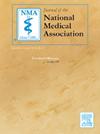Trends in cancer incidence and mortality in the United States (1999-2021): A retrospective cohort study of health disparities and regional variations
IF 2.5
4区 医学
Q1 MEDICINE, GENERAL & INTERNAL
引用次数: 0
Abstract
Objective
Analyze cancer incidence and mortality in the U.S. 1999-2021, focusing on variations by sex, race, cancer type, and state. The study aims to identify disparities in cancer rates and highlight regions and populations most affected, to inform public health policies and interventions.
Methods
Age-adjusted rates were analyzed by race, cancer type, sex, and state. Bayesian statistical techniques were employed for accurate trend estimation, and cancer hotspots were identified using the Getis-Ord Gi* statistic. Joinpoint regression was used to estimate the Average Annual Percent Change (AAPC) in cancer rates. The analysis was conducted using R.
Results
The overall trend was noted reduction in aggregate cancer rate (AAPC =−0.007) and mortality (AAPC =−0.004). Regional and racial disparities are still prevalent with outcomes showing that Kentucky, West Virginia, and Mississippi have the highest prevalence of both. Cancer incidence was reduced most significantly among Black or African American individuals (AAPC=−0.008) and mortality in (AAPC=−0.021) but their rates are still higher. Hotspot analyses identified high cancer incidence and mortality clusters, particularly in the Midwestern and Southern regions of the United States.
Discussion
The implications arising from these results suggest that focused public health campaigns need to be directed toward cancer, smoking, and access to care services for effective health promotion. These findings therefore call for innovative public health measures to reduce the burden of cancer and disparity in the future. More sophisticated studies of the social, environmental, and genetic causes of these trends are required to improve the efficacy of cancer control.
美国癌症发病率和死亡率趋势(1999-2021年):健康差异和地区差异的回顾性队列研究
目的:分析1999-2021年美国癌症发病率和死亡率,重点关注性别、种族、癌症类型和州的变化。该研究旨在确定癌症发病率的差异,突出受影响最严重的地区和人口,为公共卫生政策和干预措施提供信息。方法:按种族、癌症类型、性别和州对年龄调整率进行分析。采用贝叶斯统计技术进行准确的趋势估计,并使用Getis-Ord Gi*统计量识别癌症热点。联合点回归用于估计癌症发病率的年均百分比变化(AAPC)。结果:总体趋势是总体癌症发病率(AAPC =-0.007)和死亡率(AAPC =-0.004)降低。地区和种族差异仍然普遍存在,结果显示肯塔基州、西弗吉尼亚州和密西西比州这三个州的患病率最高。黑人或非裔美国人的癌症发病率(AAPC=-0.008)和死亡率(AAPC=-0.021)下降最为显著,但他们的发病率仍然较高。热点分析确定了高癌症发病率和死亡率集群,特别是在美国中西部和南部地区。讨论:从这些结果中产生的影响表明,有针对性的公共卫生运动需要针对癌症、吸烟和获得保健服务,以有效促进健康。因此,这些发现要求采取创新的公共卫生措施,以减轻未来癌症的负担和差距。需要对这些趋势的社会、环境和遗传原因进行更复杂的研究,以提高癌症控制的效果。
本文章由计算机程序翻译,如有差异,请以英文原文为准。
求助全文
约1分钟内获得全文
求助全文
来源期刊
CiteScore
4.80
自引率
3.00%
发文量
139
审稿时长
98 days
期刊介绍:
Journal of the National Medical Association, the official journal of the National Medical Association, is a peer-reviewed publication whose purpose is to address medical care disparities of persons of African descent.
The Journal of the National Medical Association is focused on specialized clinical research activities related to the health problems of African Americans and other minority groups. Special emphasis is placed on the application of medical science to improve the healthcare of underserved populations both in the United States and abroad. The Journal has the following objectives: (1) to expand the base of original peer-reviewed literature and the quality of that research on the topic of minority health; (2) to provide greater dissemination of this research; (3) to offer appropriate and timely recognition of the significant contributions of physicians who serve these populations; and (4) to promote engagement by member and non-member physicians in the overall goals and objectives of the National Medical Association.

 求助内容:
求助内容: 应助结果提醒方式:
应助结果提醒方式:


